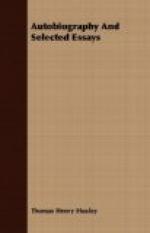I take it that the whole object of education is, in the first place, to train the faculties of the young in such a manner as to give their possessors the best chance of being happy [79] and useful in their generation; and, in the second place, to furnish them with the most important portions of that immense capitalised experience of the human race which we call knowledge of various kinds. I am using the term knowledge in its widest possible sense; and the question is, what subjects to select by training and discipline, in which the object I have just defined may be best attained.
I must call your attention further to this fact, that all the subjects of our thoughts—all feelings and propositions (leaving aside our sensations as the mere materials and occasions of thinking and feeling), all our mental furniture—may be classified under one of two heads—as either within the province of the intellect, something that can be put into propositions and affirmed or denied; or as within the province of feeling, or that which, before the name was defiled, was called the aesthetic side of our nature, and which can neither be proved nor disproved, but only felt and known.
According to the classification which I have put before you, then, the subjects of all knowledge are divisible into the two groups, matters of science and matters of art; for all things with which the reasoning faculty alone is occupied, come under the province of science; and in the broadest sense, and not in the narrow and technical sense in which we are now accustomed to use the word art, all things feelable, all things which stir our emotions, come under the term of art, in the sense of the subject-matter of the aesthetic faculty. So that we are shut up to this—that the business of education is, in the first place, to provide the young with the means and the habit of observation; and, secondly, to supply the subject-matter of knowledge either in the shape of science or of art, or of both combined.
Now, it is a very remarkable fact—but it is true of most things in this world—that there is hardly anything one-sided, or of one nature; and it is not immediately obvious what of the things that interest us may be regarded as pure science, and what may be regarded as pure art. It may be that there are some peculiarly constituted persons who, before they have advanced far into the depths of geometry, find artistic beauty about it; but, taking the generality of mankind, I think it may be said that, when they begin to learn mathematics, their whole souls are absorbed in tracing the connection between the premisses and the conclusion, and that to them geometry is pure science. So I think it may be said that mechanics and osteology are pure science. On the other hand, melody in music is pure art. You cannot reason about it; there is no proposition involved in it. So, again, in the pictorial art, an arabesque, or a “harmony in grey,"[80] touches none but the aesthetic faculty. But a great mathematician,




